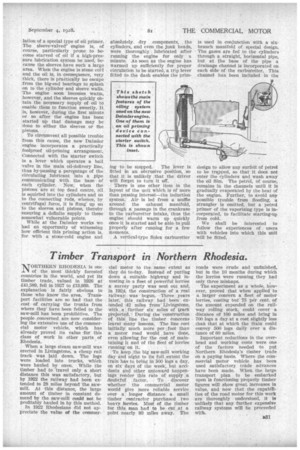Timber Transport in Northern Rhodesia.
Page 15

If you've noticed an error in this article please click here to report it so we can fix it.
NTORTHERN RHODESIA is one -1111 of the most thickly forested. countries in the world, and yet its timber trade, valued in 1926 at £41,589, fell in 1927 to £13,939. The explanation is fairly obvious to those who know the area. Transport facilities are so bad that the cost of carrying the trunks from where they have been felled to the saw-mill has been prohibitive. The people _concerned are now considering the extensive use of the commercial motor vehicle, which has already proved its value for this class of work in other parts of Rhodesia.
When a large steam saw-mill was erected in Livingstone, a cheap rail track was laid down. The logs were loaded into trucks, which were hauled by oxen. While the timber had to travel only a short distance this was satisfactory, but by 1922 the railway had been extended to 28 miles beyond the sawmill. At this distance, the large amount of timber in constant demand by the saw-mill could not be profitably hauled in by this method.
In 1922 Rhodesians did not appreciate the value of the commer cial motor to the same extent as they do to-day. Instead of putting down a suitable highway and investing in a fleet a powerful lorries a survey party was sent out and, in 1924, the construction of a real railway was begun. .Three years later, this railway had been extended 42 miles from Livingstone, with . a fiirther six miles of track projected. During the construction of this line the timber concerns learnt many lessons. The line cost initially much more per foot than a motor road would have done, even allowing for the cost of maintaining it and of the fleet of lorries running on it.
To keep the big saw-mill working day and night to its full extent the train has to bring in 500 logs a day, on six days of the week, but accidents and other untoward happenings render this rate of supply a doubtful factor. To discover whether the commercial motor would give more reliable service over a longer distance a small timber contractor purchased two heavy lorries. Most of the timber for this man had to be cut at a point nearly 80 miles away. The
roads were crude and unfinished, but in the 10 months during which the lorries were running they had only three mishaps.
The experiment as a whole, however, proved that when applied to a larger concern a fleet of motor lorries, costing but 75 per cent. of the amount expended on the railway rolling stock, could cover a distance of 100 miles and bring in 700 logs a day. at a cost slightly less . than that at which the train could convey 500 logs daily over a distance of 60 miles.
Important reductions in the overhead and working costs were one of the factors needed to put Northern Rhodesia's timber trade on a paying basis. Where the commercial motor vehicle has been used satisfactory trade advances have been made. When the large transport plan to be embarked upon is functioning properly timber figures will show great. increases in value, and now that the capabilities of the road motor for this work are thoroughly understood, it Is unlikely that any further expensive railway systems will be proceeded with.
































